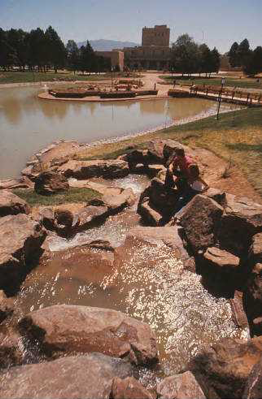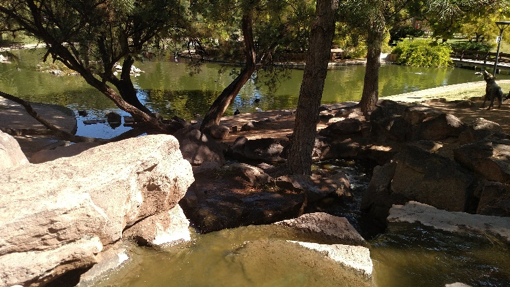
UNM Duck Pond - Then and Now
1977
The original picture, taken in 1977, shows the duck pond shortly after its construction. It is taken from over the top of the waterfall, overlooking the rest of the pond area. Its central location within campus is far easier to see in the original image, as iconic buildings (like the Zimmerman library) can be seen on the horizon. Most notably, the pond lacks any kind of vegetation and looks more akin to a barren wasteland then a communal space where students gather and looks nothing like the natural heaven it was supposed to be.
 The retaken picture however shows a completely different scene. Trees surround the area, blanketing the pond in shade. The central island as well has grown into a secret grotto, with plants almost obscuring it from view completely. The original view from the first picture is long gone as well, covered instead by a small forest of trees and other plants. Many species of animals as well can now call the duck pond their home, including fish, turtles and, of course, ducks. Just from the comparison of these two pictures you can see how much the pond has grown, both physically and metaphorically, into a central and integral part of the campus.
The retaken picture however shows a completely different scene. Trees surround the area, blanketing the pond in shade. The central island as well has grown into a secret grotto, with plants almost obscuring it from view completely. The original view from the first picture is long gone as well, covered instead by a small forest of trees and other plants. Many species of animals as well can now call the duck pond their home, including fish, turtles and, of course, ducks. Just from the comparison of these two pictures you can see how much the pond has grown, both physically and metaphorically, into a central and integral part of the campus.
While the duck pond is currently a much beloved and enjoyable part of the campus, these ideas were not always present, especially during the early construction and eventual addition of the duck pond to campus. Designed by David Eckbo and his firm EDAW, the duck pond (originally called "central park") was built with the intent to be a feature that both modernized and tied the campus together in a more harmonious manner, with a large water feature to echo the prominent features in East coast campuses. However, this unfortunately was not the case. Originally built over one of the facility parking lots, the duck pond began its time on campus shrouded in controversy. In addition to disconnect with members of the campus, the duck pond features disconnect with the entire state of New Mexico. Since New Mexico is a drought ridden desert state, large water features are seldom seen in use as they drain on New Mexico's already scarce resources. These reasons and others contribute to the idea that the duck pond actually represents a strong tear in the fabric of cultural and regional identity that the campus was so intricately designed to observe in its original architectural design.
Dispite the mixed attitudes, it is easy to see that the duck pond has become more than just an oddly placed water feature in the middle of campus. It has grown into the major gathering place on campus and is almost never devoid of student life. Even for people who don't attend UNM, the duck pond remains to be a prominent feature showing not only how the duck pond has become so central to UNM, but how UNM has become so central to Albuquerque.
Lucia DeMartino, History, 2020
Gwendolyn Orr-Dick, Japanese, 2020
